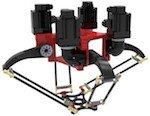|
|
|
|
Rigidity Theory for Multi-agent Systems Meets Parallel Robots: Towards the Discovery of Common Models and Methods This workshop is the second event on the topic "Rigidity Theory for Multi-agent Systems Meets Parallel Robots: Towards the Discovery of Common Models and Methods". The first workshop was organized during the IFAC WC Congress in July 2017 in Toulouse and was a successfull event, leading to the organization of this second workshop. The goals of this series of workshop are to explore connections and encourage discussion between two historically distinct communities: the parallel robotics community and the multi-robot community (for what concerns, generally speaking, rigidity-based methods for distributed formation control and localization). Indeed, although these two areas may appear as quite distant, they actually share a strong common underline theme: understanding how pairwise geometrical constraints (e.g., relative distances or angles) can affect the mobility or state (pose) estimation for robotic systems. Moreover, there is a strong analogy between multi-agent systems and parallel robots: each robot of the system can be seen as a passive joint of a virtual mechanical (parallel) architecture and each measurement between two robots as a rigid connection between them, rigid connection whose dimension can vary thanks to a virtual actuator. So it is possible to find virtual parallel robot architectures associated with multi-agent systems. Rigidity-based multi-robot control/estimation is typically concerned about topics such as: (i) understanding what is the minimum number of edges (of constraints) for ensuring rigidity in some configuration space, (ii) characterizing the (infinitesimal) motions of a formation that preserve desired shapes, (iii) stabilizing a rigid formation towards desired shapes, (iv) reconstruct the formation shape/pose from local pair-wise measurements, or (v) maintaining for- mation rigidity at runtime despite sensing/communication constraints. Parallel robotics is instead concerned about (i) finding the solutions of complex algebraic equations associated with the estimation of the configuration of the end-effector for a given set of active joint positions, and (ii) finding the singular configurations leading to a loss of controllability for the end-effector (loss of mechanical rigidity). These problems in both fields have some similarities that we propose to explore. The next two sections give a more detailed overview of both communities. Scope This workshop hopes to bring together, at the highest level, audiences from the robotics community and the controls community. We hope the workshop will be of particular interest to researchers and students focusing on formation control theory and parallel robotics. The expected learning outcome of this workshop is to provide every attendant with a clear picture of both communities (open problems, tools, methods, ideas) and of how the two worlds could benefit from each other. This event will not be advertised on the classical diffusion channels (EuRobotics and WorldwideRobotics mailing lists). It is prefered to organize an intimate event that is only opened (under invitation) to researchers motivated by a cross-fertilization between both research fields. Moreover, there is no registration fee (and travel/accommodation should be covered by each participant on her/his own budget). Location This workshop will take place in Nantes, France. Nantes is a nice city, with a long and interesting history (https://en.wikipedia.org/wiki/Nantes), and with a very strong tradition in robotics, mechanics and control. Its access with respect to Paris airports is very convenient (5-6 direct 1-hour flights both from Paris Charles de Gaulle and Roissy per days, 1 direct train (TGV) from Paris per hour (2 hours of travel)). Finally, Nantes hosts one of the main french communities in parallel robotics. The exact location of the workshop is: Ecole Centrale de Nantes Google maps: https://goo.gl/maps/UByLkrHdzuQ2
More information for your venue on the workshop site can be found here. Program DAY 1 8:45 -- 9:15: Welcome of participants Session 1 (9:15–12:45, w/ coffee break at 11:15)
Speakers:
Title of the presentation: Design and control of lying parallel robots
Title of the presentation: Singularity analysis of lower-mobility parallel manipulators based on Grassmann-Cayley algebra and Grassmann geometry
Title of the presentation: Aerial Co-Manipulation with Cables: The Role of Internal Force for Equilibria, Stability, and Passivity
Session 2 (14:30–16:30, w/ coffee break at 16:30)
Speakers:
Title of the presentation: Cables and flexible rods as parallel robot legs: modeling and analysis issues
Title of the presentation: Physical Interpretation of Rigidity for Bearing Formations
Panel Discussion (16:45–17:45) A focused panel discussion aimed to wrap up the various contributions and discuss possible concrete ways of cross-exploiting tools/ideas from the two communities. ------ DAY 2 (9:20–16:30) Session 3 (9:20–12:00, w/ coffee break at 10:30) - Oral presentations
Program: 9h20-10h00: Marco Carricato and Yuanqing Woo (parallel robotics, Univ. Bologna) 10h00-10h20: Julian Erskine (aerial cable-driven robotics, Ecole Centrale Nantes - LS2N) 10h20-10h40: coffee break 10h40-11h00: Pedro Castillo-Garcia (control of multi-agent systems, CNRS-Heudiasyc) 11h00-11h20: Christophe Jermann (graph theory, interval analysis - Univ. Nantes, LS2N) 11h20-11h40: Angelo Cenedese (Formation control, Univ. Padova) 11h40-12h00: Alexandre Goldsztejn (interval analysis, CNRS-LS2N)
Session 4 (14:00–16:30, w/ coffee break at 11:00) - Workgroups Setting up small groups of participants, including people from both research fields, in order to discuss on some specific topics of interest highlighted during the first day or the workshop in Nantes Organized by Antonio Franchi Sébastien Briot Paolo Robuffo Giordano |


